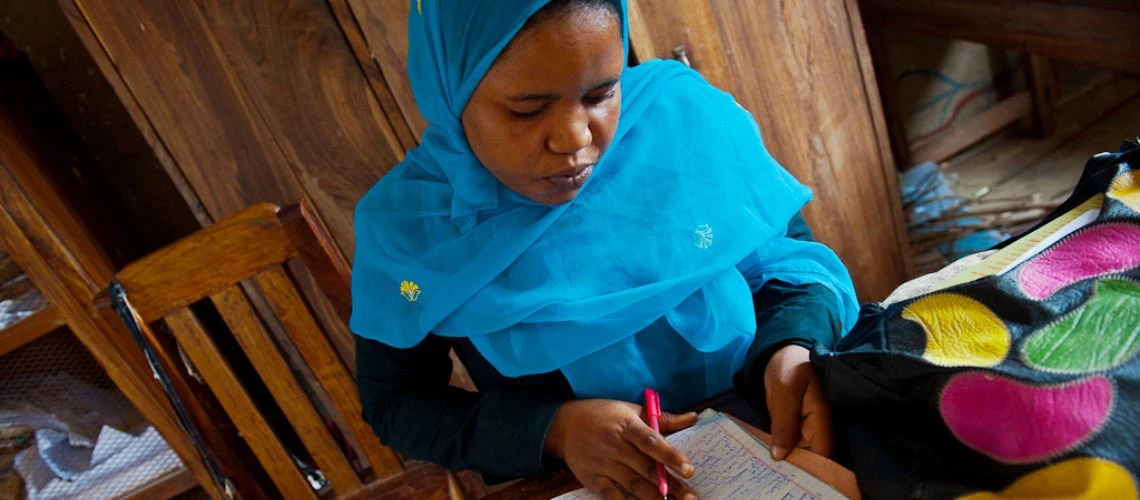

Four of the biggest problems facing education—and four trends that could make a difference
Eduardo velez bustillo, harry a. patrinos.

In 2022, we published, Lessons for the education sector from the COVID-19 pandemic , which was a follow up to, Four Education Trends that Countries Everywhere Should Know About , which summarized views of education experts around the world on how to handle the most pressing issues facing the education sector then. We focused on neuroscience, the role of the private sector, education technology, inequality, and pedagogy.
Unfortunately, we think the four biggest problems facing education today in developing countries are the same ones we have identified in the last decades .
1. The learning crisis was made worse by COVID-19 school closures
Low quality instruction is a major constraint and prior to COVID-19, the learning poverty rate in low- and middle-income countries was 57% (6 out of 10 children could not read and understand basic texts by age 10). More dramatic is the case of Sub-Saharan Africa with a rate even higher at 86%. Several analyses show that the impact of the pandemic on student learning was significant, leaving students in low- and middle-income countries way behind in mathematics, reading and other subjects. Some argue that learning poverty may be close to 70% after the pandemic , with a substantial long-term negative effect in future earnings. This generation could lose around $21 trillion in future salaries, with the vulnerable students affected the most.
2. Countries are not paying enough attention to early childhood care and education (ECCE)
At the pre-school level about two-thirds of countries do not have a proper legal framework to provide free and compulsory pre-primary education. According to UNESCO, only a minority of countries, mostly high-income, were making timely progress towards SDG4 benchmarks on early childhood indicators prior to the onset of COVID-19. And remember that ECCE is not only preparation for primary school. It can be the foundation for emotional wellbeing and learning throughout life; one of the best investments a country can make.
3. There is an inadequate supply of high-quality teachers
Low quality teaching is a huge problem and getting worse in many low- and middle-income countries. In Sub-Saharan Africa, for example, the percentage of trained teachers fell from 84% in 2000 to 69% in 2019 . In addition, in many countries teachers are formally trained and as such qualified, but do not have the minimum pedagogical training. Globally, teachers for science, technology, engineering, and mathematics (STEM) subjects are the biggest shortfalls.
4. Decision-makers are not implementing evidence-based or pro-equity policies that guarantee solid foundations
It is difficult to understand the continued focus on non-evidence-based policies when there is so much that we know now about what works. Two factors contribute to this problem. One is the short tenure that top officials have when leading education systems. Examples of countries where ministers last less than one year on average are plentiful. The second and more worrisome deals with the fact that there is little attention given to empirical evidence when designing education policies.
To help improve on these four fronts, we see four supporting trends:
1. Neuroscience should be integrated into education policies
Policies considering neuroscience can help ensure that students get proper attention early to support brain development in the first 2-3 years of life. It can also help ensure that children learn to read at the proper age so that they will be able to acquire foundational skills to learn during the primary education cycle and from there on. Inputs like micronutrients, early child stimulation for gross and fine motor skills, speech and language and playing with other children before the age of three are cost-effective ways to get proper development. Early grade reading, using the pedagogical suggestion by the Early Grade Reading Assessment model, has improved learning outcomes in many low- and middle-income countries. We now have the tools to incorporate these advances into the teaching and learning system with AI , ChatGPT , MOOCs and online tutoring.
2. Reversing learning losses at home and at school
There is a real need to address the remaining and lingering losses due to school closures because of COVID-19. Most students living in households with incomes under the poverty line in the developing world, roughly the bottom 80% in low-income countries and the bottom 50% in middle-income countries, do not have the minimum conditions to learn at home . These students do not have access to the internet, and, often, their parents or guardians do not have the necessary schooling level or the time to help them in their learning process. Connectivity for poor households is a priority. But learning continuity also requires the presence of an adult as a facilitator—a parent, guardian, instructor, or community worker assisting the student during the learning process while schools are closed or e-learning is used.
To recover from the negative impact of the pandemic, the school system will need to develop at the student level: (i) active and reflective learning; (ii) analytical and applied skills; (iii) strong self-esteem; (iv) attitudes supportive of cooperation and solidarity; and (v) a good knowledge of the curriculum areas. At the teacher (instructor, facilitator, parent) level, the system should aim to develop a new disposition toward the role of teacher as a guide and facilitator. And finally, the system also needs to increase parental involvement in the education of their children and be active part in the solution of the children’s problems. The Escuela Nueva Learning Circles or the Pratham Teaching at the Right Level (TaRL) are models that can be used.
3. Use of evidence to improve teaching and learning
We now know more about what works at scale to address the learning crisis. To help countries improve teaching and learning and make teaching an attractive profession, based on available empirical world-wide evidence , we need to improve its status, compensation policies and career progression structures; ensure pre-service education includes a strong practicum component so teachers are well equipped to transition and perform effectively in the classroom; and provide high-quality in-service professional development to ensure they keep teaching in an effective way. We also have the tools to address learning issues cost-effectively. The returns to schooling are high and increasing post-pandemic. But we also have the cost-benefit tools to make good decisions, and these suggest that structured pedagogy, teaching according to learning levels (with and without technology use) are proven effective and cost-effective .
4. The role of the private sector
When properly regulated the private sector can be an effective education provider, and it can help address the specific needs of countries. Most of the pedagogical models that have received international recognition come from the private sector. For example, the recipients of the Yidan Prize on education development are from the non-state sector experiences (Escuela Nueva, BRAC, edX, Pratham, CAMFED and New Education Initiative). In the context of the Artificial Intelligence movement, most of the tools that will revolutionize teaching and learning come from the private sector (i.e., big data, machine learning, electronic pedagogies like OER-Open Educational Resources, MOOCs, etc.). Around the world education technology start-ups are developing AI tools that may have a good potential to help improve quality of education .
After decades asking the same questions on how to improve the education systems of countries, we, finally, are finding answers that are very promising. Governments need to be aware of this fact.
To receive weekly articles, sign-up here
Get updates from Education for Global Development
Thank you for choosing to be part of the Education for Global Development community!
Your subscription is now active. The latest blog posts and blog-related announcements will be delivered directly to your email inbox. You may unsubscribe at any time.

Consultant, Education Sector, World Bank

Senior Adviser, Education
Join the Conversation
- Share on mail
- comments added
The Ongoing Challenges, and Possible Solutions, to Improving Educational Equity

- Share article
Schools across the country were already facing major equity challenges before the pandemic, but the disruptions it caused exacerbated them.
After students came back to school buildings after more than a year of hybrid schooling, districts were dealing with discipline challenges and re-segregating schools. In a national EdWeek Research Center survey from October, 65 percent of the 824 teachers, and school and district leaders surveyed said they were more concerned now than before the pandemic about closing academic opportunity gaps that impact learning for students of different races, socioeconomic levels, disability categories, and English-learner statuses.
But educators trying to prioritize equity have an uphill battle to overcome these challenges, especially in the face of legislation and school policies attempting to fight equity initiatives across the country.
The pandemic and the 2020 murder of George Floyd drove many districts to recognize longstanding racial disparities in academics, discipline, and access to resources and commit to addressing them. But in 2021, a backlash to such equity initiatives accelerated, and has now resulted in 18 states passing laws restricting lessons on race and racism, and many also passing laws restricting the rights and well-being of LGBTQ students.
This slew of Republican-driven legislation presents a new hurdle for districts looking to address racial and other inequities in public schools.
During an Education Week K-12 Essentials forum last week, journalists, educators, and researchers talked about these challenges, and possible solutions to improving equity in education.
Takeru Nagayoshi, who was the Massachusetts teacher of the year in 2020, and one of the speakers at the forum, said he never felt represented as a gay, Asian kid in public school until he read about the Stonewall Riots, the Civil Rights Movement, and the full history of marginalized groups working together to change systems of oppression.
“Those are the learning experiences that inspired me to be a teacher and to commit to a life of making our country better for everyone,” he said.
“Our students really benefit the most when they learn about themselves and the world that they’re in. They’re in a safe space with teachers who provide them with an honest education and accurate history.”
Here are some takeaways from the discussion:

Schools are still heavily segregated
Almost 70 years after the Supreme Court ruled in Brown v. Board of Education that racial segregation in public schools was unconstitutional, most students attend schools where they see a majority of other students of their racial demographics .
Black students, who accounted for 15 percent of public school enrollment in 2019, attended schools where Black students made up an average of 47 percent of enrollment, according to a UCLA report.
They attended schools with a combined Black and Latinx enrollment averaging 67 percent, while Latinx students attended schools with a combined Black and Latinx enrollment averaging 66 percent.
Overall, the proportion of schools where the majority of students are not white increased from 14.8 percent of schools in 2003 to 18.2 percent in 2016.
“Predominantly minority schools [get] fewer resources, and that’s one problem, but there’s another problem too, and it’s a sort of a problem for democracy,” said John Borkowski, education lawyer at Husch Blackwell.
“I think it’s much better for a multi-racial, multi-ethnic democracy, when people have opportunities to interact with one another, to learn together, you know, and you see all of the problems we’ve had in recent years with the rising of white supremacy, and white supremacist groups.”
School discipline issues were exacerbated because of student trauma
In the absence of national data on school discipline, anecdotal evidence and expert interviews suggest that suspensions—both in and out of school—and expulsions, declined when students went remote.
In 2021, the number of incidents increased again when most students were back in school buildings, but were still lower than pre-pandemic levels , according to research by Richard Welsh, an associate professor of education and public policy at Vanderbilt’s Peabody College of Education.
But forum attendees, who were mostly district and school leaders as well as teachers, disagreed, with 66 percent saying that the pandemic made school incidents warranting discipline worse. That’s likely because of heightened student trauma from the pandemic. Eighty-three percent of forum attendees who responded to a spot survey said they had noticed an increase in behavioral issues since resuming in-person school.
Restorative justice in education is gaining popularity
One reason Welsh thought discipline incidents did not yet surpass pre-pandemic levels despite heightened student trauma is the adoption of restorative justice practices, which focus on conflict resolution, understanding the causes of students’ disruptive behavior, and addressing the reason behind it instead of handing out punishments.
Kansas City Public Schools is one example of a district that has had improvement with restorative justice, with about two thirds of the district’s 35 schools seeing a decrease in suspensions and expulsions in 2021 compared with 2019.
Forum attendees echoed the need for or success of restorative justice, with 36 percent of those who answered a poll within the forum saying restorative justice works in their district or school, and 27 percent saying they wished their district would implement some of its tenets.
However, 12 percent of poll respondents also said that restorative justice had not worked for them. Racial disparities in school discipline also still persist, despite restorative justice being implemented, which indicates that those practices might not be ideal for addressing the over-disciplining of Black, Latinx, and other historically marginalized students.
Sign Up for The Savvy Principal
Edweek top school jobs.

Sign Up & Sign In


IMAGES
VIDEO